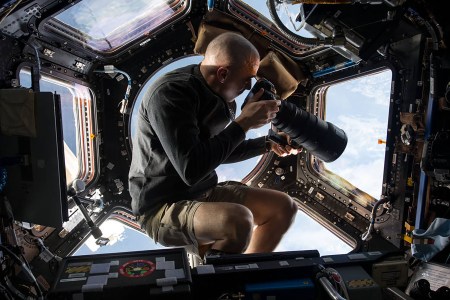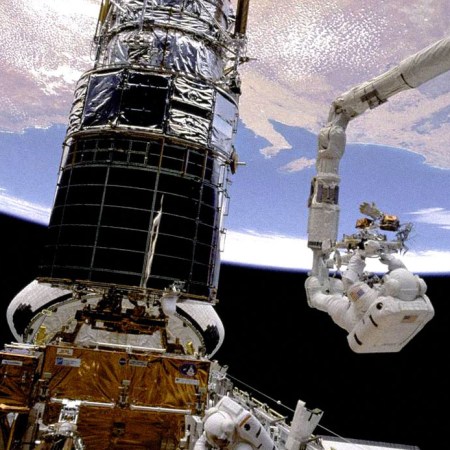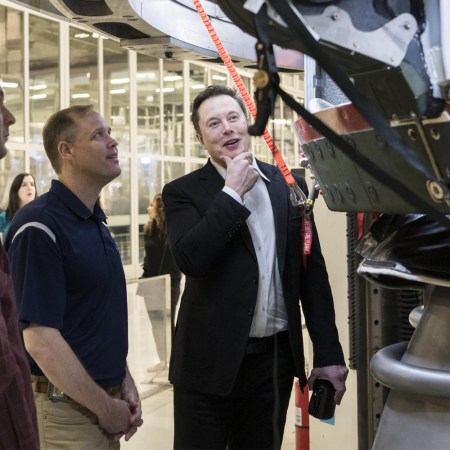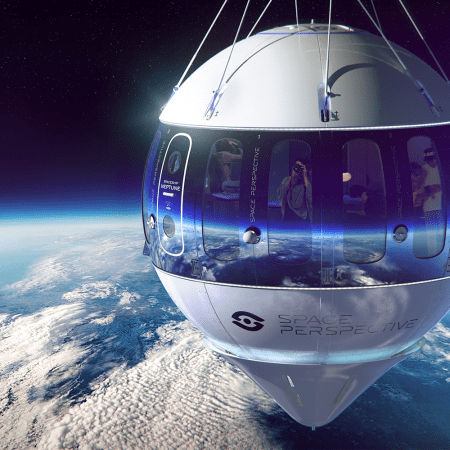Deep in the desert of Utah sits a small colony of white buildings. The occupants, who stay in the curious settlement for two to three weeks at a time, are careful not to leave without what they call their “spacesuits.” That’s because they’re exploring the technology, operations and conditions required to someday live on Mars.
The research facility, which includes airlocks, an observatory and aquaponic growing system, was established by the Mars Society. The organization has now circulated over 270 crews through the site and simulated a total of 7.5 years of living on Mars, a huge and complex undertaking. Unsurprisingly, Robert Zubrin, its founder, has no doubt about our need to go to the Red Planet — and he is emphatic about the need to send humans to Mars, not just metal boxes of sensors on wheels.
“There is simply no comparison in terms of what people can achieve relative to robots,” Zubrin, author of the upcoming book The New World on Mars: What We Can Create on the Red Planet, tells InsideHook. “Look at what the crew of Apollo 17 achieved in three days [of work on the surface of the moon] relative to what the Mars landers have done in a decade, and I don’t think there’s an argument.”
There are, he says, plenty of “very productive” advantages to pushing for human spaceflight over the robotic option. If the space race of the 1960s was driven by intense geopolitical competition, maybe that will prove an incentive again now that China, India and the UAE are making big moves in the galactic game. Getting robots to land on Mars is impressive. Getting people there first would be, among many other things, a massive boost to national self-confidence for whichever nation pulled it off.
Zubrin is not alone in the contention that the future of space exploration needs to be manned. According to Ian Crawford, professor of planetary science and astrobiology at the University of London, and a long-time campaigner for manned spaceflight — and not just the puttering about in low Earth orbit on the International Space Station, he stresses — it’s a simple matter of effectiveness and productivity.
Robots will certainly be far more advanced in the future, but for now they are small, thus limited in the tools they can deploy, and slow. NASA’s Curiosity rover is faster than previous machines, but it still moves 13 times slower than a crawling human, he notes. What the Insight lander on Mars took two years trying to do — dig a 17-inch-deep hole — would take an astronaut just a few minutes. (As far as advancing human understanding goes, samples like these are crucial; it was only last month that an ongoing study of samples returned 51 years ago by Apollo 17 has allowed us to work out that the moon is, in fact, 40 million years older than previously understood.) Humans have agency, and they can decide to do things on the fly and respond to happy accidents.
“Geology requires hiking long distances over difficult terrain, both heavy and delicate work, and following up intuitive clues,” says Zubrin. “I live in Colorado in one of the most famous locations for dinosaur fossil finds, and you could parachute 100 rovers into the area and they wouldn’t find one. To speak of robots that can do anything like the things people can do is to be in the realms of science fiction — more than that, of fantasy.”
“The fact is it’s people who have to go to Mars.”
The End of the Astronaut?
Not everyone is buying the human-first approach, and not least because manned spaceflight is incredibly expensive, certainly relative to robots. Robots have already proven themselves in fulfilling the role of pathfinders ahead of people: Much as the Lunar Orbiter, Ranger and Surveyor probes all did essential analysis of the moon’s surface ahead of Apollo 11’s landing, so the Perseverance rover, which landed in 2021, is doing the same on Mars now. Robots have landed on asteroids and comets, operated drones — in 2021, the Ingenuity helicopter made the first flight on a celestial body other than Earth — and successfully converted the atmosphere on Mars into oxygen.
Of course, robots themselves don’t need oxygen. They don’t need water or food or sleep, either — the supply of which, to us humans, amounts to huge challenges, especially over the greater distances of spaceflight now being pondered. If settlement is the goal, things get even harder. If it takes about three days to get to the moon, it’s going to take about nine months — one way — to get to Mars with current technology. To get to the next orbital stop in the solar system, Jupiter, you’re looking at over five years.
Small wonder then that Martin Rees, cosmologist and the U.K.’s Astronomer Royal, thinks we’re already at what he calls “the end of the astronaut” (that’s also the title of his recent co-authored book). For all the hubbub around the U.S. recently rebooting its Artemis program to hopefully go back to the moon by the end of 2025, the moon, and maybe Mars, looks to be the end of the line for human expansion. As a point of comparison, Rees notes that although NASA has, since its inception, spent 60% more on manned space exploration than robotic, robots have made it to the outer reaches of our solar system while people have only got as far as the moon, the end of the celestial garden path.
“The fact is that robots are getting better and cheaper all the time,” says Rees, “so I don’t see a case for that huge public expenditure of sending people into space. It’s going to cost $90 billion to send people back to the moon — trillions for Mars — and, even from a practical standpoint, the case for doing so isn’t strong. We’ve been so exposed to space themes in movies in the 60 years since Armstrong, it’s hard to know what impact it would have. And in time, robots will be able to assemble large structures. They will be able to mine.”
What It’s Like to Be Alone on the International Space Station
Former Navy SEAL Chris Cassidy spent 378 days in space. On his last mission, during COVID, he was one of only three people on the ISS.It’s not just about the money, either, though convincing the public that such vast expenditure is worth it, especially in the face of such huge problems here on Earth, isn’t an easy pitch. The problem is more that human beings are needy and fragile and dirty. They like their creature comforts. And much beyond Mars, a combination of continued exposure to microgravity, unpredictable solar flares and radiation makes space deadly: an astronaut going to Mars will be subject to around 60% of the radiation dose recommended for their entire space-faring career.
Joshua Colwell, professor of physics at the University of Central Florida, has put forward the idea that the answer to the Fermi paradox — if the universe is full of life, where is everybody? — is that space travel is simply too inhospitable to all life.
“And that’s kind of depressing to me, because I can’t think of any discovery that would be more transformational for human civilization [than contact with life on other planets],” Colwell says. “Maybe we’re not alone in the universe, but nonetheless we’re condemned to be alone.”
“Spaceflight Is Inherently Dangerous”
According to Rees, there’s a potential solution for the inhospitality factor. Much as robots will get more advanced in the future (faster, more capable, driven by artificial intelligence), so will humans. If people are to explore deep space, he proposes, it will likely not be by the kind of humans we know. Rather, it will be — after, no doubt, a lot of ethical handwringing — humans that have been modified through cybernetics or genetics.
“It will be other, new types of humans that may spread through the galaxy over a very long timescale,” Rees says. “I certainly don’t think that anything like humans as we know them will be doing interstellar travel.”
At least, not without accepting that they may be on a one-way trip, or that the trip has a high likelihood of failure. Part of the problem now, argues Daniel Britt, professor of astronomy and planetary sciences at the University of Central Florida, is that we are too risk-averse. The public has been spoon-fed the idea that spaceflight is much safer than it is, and making it as safe as it imagines only adds to the huge costs.
“To speak of robots that can do anything like the things people can do is to be in the realms of science fiction — more than that, of fantasy. The fact is it’s people who have to go to Mars.”
Robert Zubrin, founder of the Mars Society
The government bureaucracies that drive much of our efforts in space, mindful of the need to keep the public onside in order to sustain very large budgets, are timid in the face of possible loss of life. Individual project managers are happier to kick the can down the road so nobody dies on their watch. You can’t blame them: the NASA Space Shuttle program had a less than 2% failure rate, but the public reaction to its two crashes — Challenger and Columbia — was obviously focused on the deaths of astronauts, not that statistical figure.
“The NASA PR machine runs this astronaut worship to the extreme, so the public gets very upset when you kill a handful of astronauts, even if nobody gives a shit if you kill an equal number of test pilots,” says Britt. “But what do you expect? Spaceflight is inherently dangerous. Probably governments’ risk aversion is a recipe for doing very little actual exploration. It’s a corner NASA paints itself into. But when you do new stuff, you get it wrong all the time. And if you don’t get it wrong then you’re obviously not doing enough.”
That may leave the truly adventurous space exploration to commercial, entrepreneurial enterprises like SpaceX, who are free to take a more frontier approach and employ those frontiersmen and women who accept the danger. As Zubrin philosophically puts it, “Sure, people die doing stuff — people died to create any of the great works of our civilization — and people die not doing stuff too.”
Where No Man Has Gone Before
Don’t we need to start taking baby steps to escape a dying, overpopulated, underfed, critically polluted, unendingly war-torn, AI totalitarian — pick your disaster movie scenario — planet Earth? Rees isn’t convinced.
“It’s a dangerous illusion to think [as some do] that we can escape Earth’s problems by going to Mars,” he says. “Of course we might mess it all up here. And yes, the planet won’t be habitable after a billion years because of a dying sun. But that’s a very long time even on a Darwinian timescale — that’s longer than it’s taken us to evolve from the fish in the sea.”
There is, perhaps, one last argument in favor of human space exploration, one that robots just can’t top. Robots may do science, but they miss the sheer romance of it all; they don’t contribute to the human spirit for adventure, for thinking as George Mallory did when asked why he wanted to climb Everest: “Because it’s there.”
“I’m not very bullish on the future of manned spaceflight and maybe it’s only some fraction of society that is actually enthralled with the idea of becoming an interplanetary species,” says Colwell. “But I do think something intangible is lost in [not pursuing] people’s innate desire to go to the next place. We lose some sense of possibility for us.”
Putting aside the distances, the dangers, the technical challenges and the bill at the end of it all, it’s the incalculable cultural payback that matters. While the Earth may be beset with various prospects of doom of our own making, going where no one has gone before shows we are still capable of sublime acts. But it is very hard for accountants to put a price on that.
This article was featured in the InsideHook newsletter. Sign up now.

























